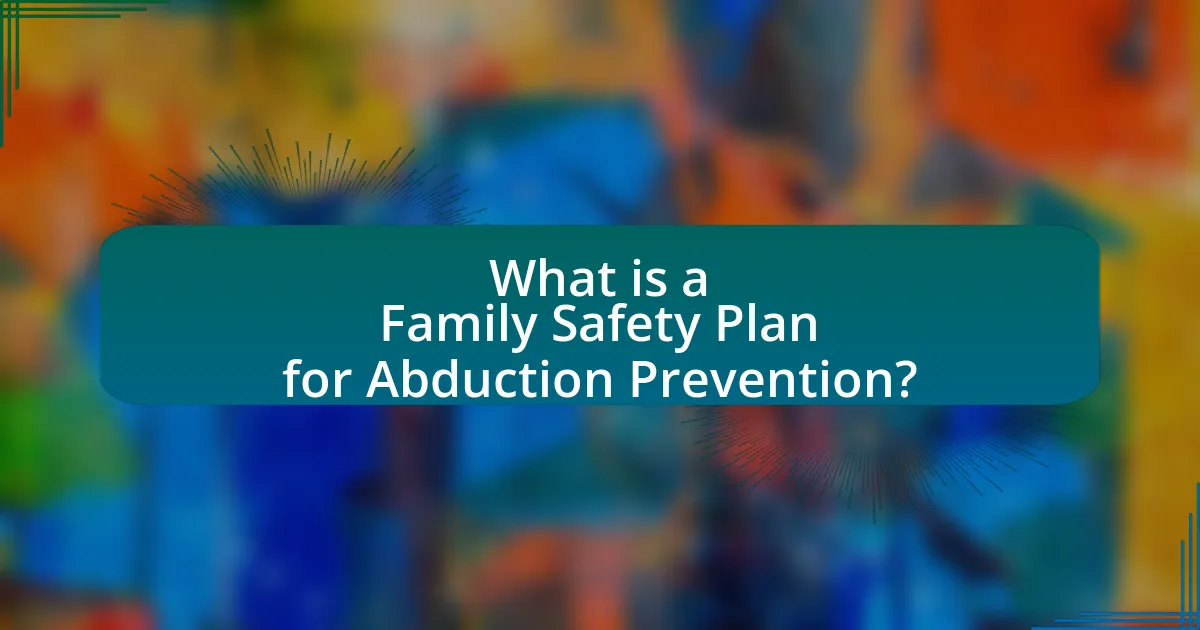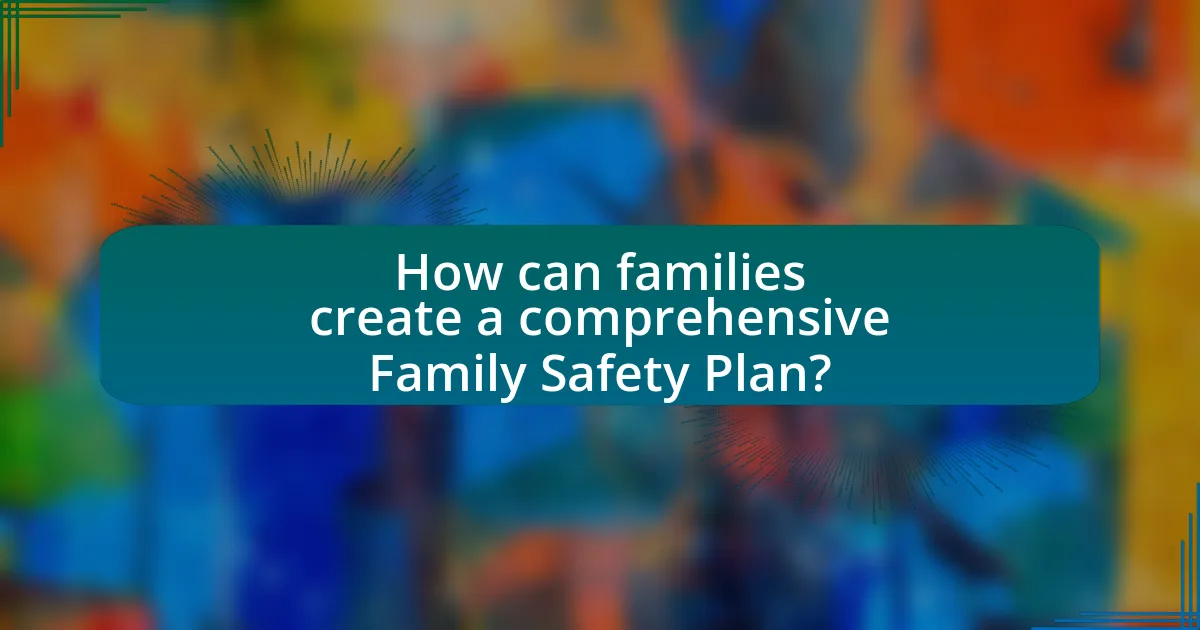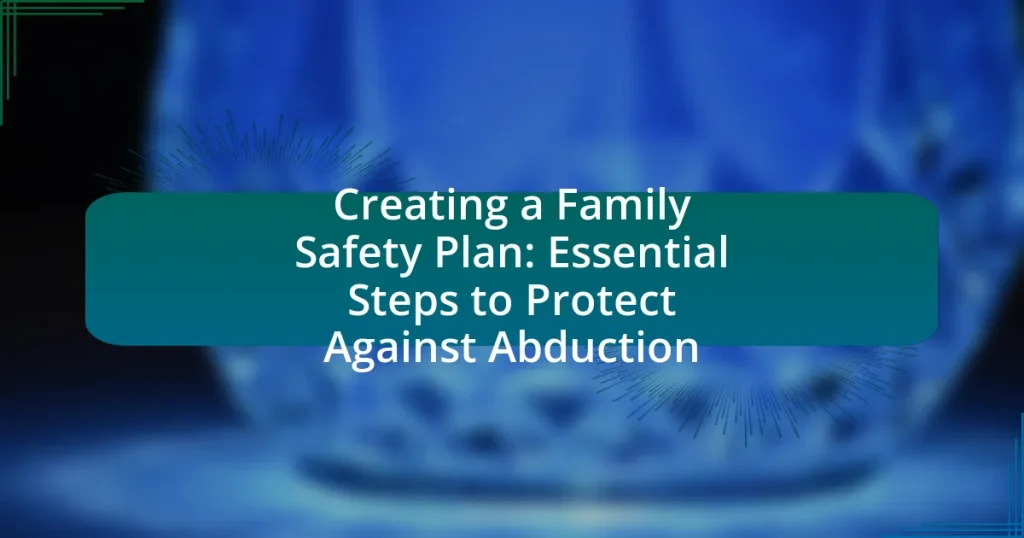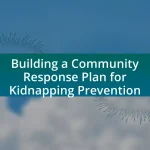A Family Safety Plan for Abduction Prevention is a structured strategy designed to protect children from potential abduction through clear protocols and communication methods. This article outlines the importance of such a plan, emphasizing the need for education, designated safe spaces, and trusted adults to empower family members in emergency situations. It highlights alarming statistics regarding child abduction, discusses the key components of an effective safety plan, and provides practical steps for families to assess risks, implement safety measures, and utilize technology to enhance their preparedness. Additionally, it addresses common challenges families may face in maintaining and practicing their safety plans, ensuring that all members understand their roles in safeguarding against abduction.

What is a Family Safety Plan for Abduction Prevention?
A Family Safety Plan for Abduction Prevention is a structured approach that families develop to protect children from potential abduction. This plan typically includes strategies such as establishing safe words, identifying trusted adults, and teaching children how to recognize and respond to dangerous situations. Research indicates that children who are educated about safety measures are less likely to become victims of abduction, highlighting the importance of proactive planning.
Why is a Family Safety Plan important for protecting against abduction?
A Family Safety Plan is crucial for protecting against abduction because it establishes clear protocols and communication strategies that empower family members to respond effectively in emergencies. By outlining specific actions to take in the event of a potential abduction, such as designated safe locations and trusted contacts, families can enhance their preparedness and reduce panic during critical situations. Research indicates that having a structured plan significantly increases the likelihood of a positive outcome in abduction scenarios, as it allows individuals to act swiftly and decisively.
What statistics highlight the need for a Family Safety Plan?
In the United States, approximately 800,000 children are reported missing each year, highlighting the urgent need for a Family Safety Plan. This statistic underscores the reality that one in every 5 children will be approached by a stranger, emphasizing the importance of preparedness. Furthermore, the National Center for Missing and Exploited Children reports that 90% of abducted children are taken by someone they know, reinforcing the necessity for families to establish clear safety protocols. These statistics illustrate the critical nature of having a Family Safety Plan to protect children from potential abduction scenarios.
How can a Family Safety Plan empower family members?
A Family Safety Plan empowers family members by providing clear guidelines and strategies for responding to potential threats, such as abduction. This structured approach enhances awareness and preparedness, enabling each member to understand their roles and responsibilities in emergency situations. Research indicates that families with established safety plans report higher confidence levels and improved communication during crises, which can significantly reduce panic and confusion. By practicing scenarios outlined in the plan, family members develop critical skills that enhance their ability to react effectively, thereby increasing their overall safety and security.
What are the key components of an effective Family Safety Plan?
An effective Family Safety Plan includes clear communication protocols, designated safe locations, emergency contact lists, and safety education for all family members. Clear communication protocols ensure that family members know how to reach each other during emergencies, while designated safe locations provide a predetermined place for family members to gather if separated. Emergency contact lists should include phone numbers of trusted individuals outside the immediate family, facilitating quick communication. Safety education involves teaching children about recognizing dangerous situations and how to respond appropriately, which is crucial for their protection against abduction.
What roles do communication and education play in the plan?
Communication and education are critical components of a family safety plan aimed at preventing abduction. Effective communication ensures that all family members understand the safety protocols, recognize potential dangers, and know how to respond in emergencies. Education empowers family members, particularly children, with knowledge about safe behaviors, recognizing suspicious activities, and understanding the importance of reporting concerns to trusted adults. Research indicates that children who receive safety education are more likely to employ protective strategies, thereby reducing their risk of abduction.
How can family members identify safe spaces and trusted adults?
Family members can identify safe spaces and trusted adults by evaluating environments and individuals based on specific criteria. Safe spaces are typically locations where children feel secure, such as homes of family friends, schools with supportive staff, or community centers with established safety protocols. Trusted adults are those who demonstrate reliability, have a history of positive interactions with the family, and are willing to support children in times of need. Research indicates that children are more likely to seek help from adults they perceive as approachable and trustworthy, reinforcing the importance of open communication and relationship-building within the family unit.

How can families create a comprehensive Family Safety Plan?
Families can create a comprehensive Family Safety Plan by identifying potential risks, establishing clear communication protocols, and practicing emergency procedures. First, families should assess their environment to identify specific threats, such as abduction risks, and then develop strategies to mitigate these threats. Next, they must create a communication plan that includes designated meeting points, emergency contacts, and methods for reaching each other in case of separation. Additionally, families should conduct regular drills to ensure that all members understand their roles and responsibilities during an emergency. Research indicates that families with practiced safety plans are better prepared to respond effectively to crises, thereby reducing the likelihood of negative outcomes.
What steps should families take to develop their plan?
Families should take the following steps to develop their safety plan: first, identify potential risks and scenarios related to abduction, such as locations or situations where children may be vulnerable. Next, establish clear communication protocols, including safe words and designated meeting places. Families should also educate children about safety measures, such as recognizing suspicious behavior and knowing how to seek help. Additionally, families should regularly review and practice the plan to ensure everyone understands their roles and responsibilities. Research indicates that families with practiced safety plans are better prepared to respond effectively in emergencies, reducing the likelihood of abduction.
How can families assess their unique risks and vulnerabilities?
Families can assess their unique risks and vulnerabilities by conducting a thorough evaluation of their environment, lifestyle, and potential threats. This assessment involves identifying specific factors such as the neighborhood’s crime rate, the family’s daily routines, and any previous incidents that may indicate vulnerabilities. For instance, families can utilize crime statistics from local law enforcement agencies to understand the prevalence of abduction or related crimes in their area. Additionally, engaging in discussions about safety with family members can help uncover personal concerns and experiences that may highlight unique risks. By combining statistical data with personal insights, families can create a comprehensive picture of their vulnerabilities, enabling them to develop targeted safety strategies.
What resources are available to assist in creating a Family Safety Plan?
Resources available to assist in creating a Family Safety Plan include government websites, non-profit organizations, and community programs. The U.S. Department of Justice provides guidelines and templates for family safety plans, while organizations like the National Center for Missing & Exploited Children offer educational materials and resources tailored to preventing abduction. Additionally, local law enforcement agencies often conduct workshops and provide resources to help families develop effective safety plans. These resources are designed to equip families with the knowledge and tools necessary to enhance their safety and preparedness against potential abduction threats.
How can families practice and implement their safety plan?
Families can practice and implement their safety plan by conducting regular drills, discussing safety protocols, and ensuring all members understand their roles. Regular drills help reinforce the procedures and make them second nature, while discussions allow families to address any concerns and update the plan as needed. Research indicates that families who practice their safety plans are better prepared for emergencies, as consistent practice increases familiarity and confidence in executing the plan effectively.
What drills and scenarios should families rehearse regularly?
Families should regularly rehearse emergency drills such as fire evacuation, home invasion response, and abduction prevention scenarios. Practicing fire evacuation ensures that all family members know the quickest exit routes and designated meeting points, which is crucial as, according to the National Fire Protection Association, nearly 3,000 people die in home fires annually. Home invasion response drills prepare families for potential intruders, emphasizing the importance of staying quiet and calling for help, which can be vital in a real situation. Additionally, abduction prevention scenarios, including “what to do if approached by a stranger,” help children recognize dangerous situations and respond appropriately, as studies show that children who practice these scenarios are more likely to react effectively in real-life situations.
How can families ensure everyone understands their roles in the plan?
Families can ensure everyone understands their roles in the plan by conducting regular meetings to discuss and clarify each member’s responsibilities. These meetings should include detailed explanations of the safety plan, allowing for questions and feedback to ensure comprehension. Research indicates that clear communication and role definition significantly enhance the effectiveness of safety protocols, as evidenced by studies showing that families who practice emergency plans are better prepared in crisis situations.

What are common challenges in maintaining a Family Safety Plan?
Common challenges in maintaining a Family Safety Plan include lack of regular updates, inconsistent communication among family members, and difficulty in practicing safety drills. Regular updates are essential because circumstances change, such as new threats or changes in family dynamics, which can render an outdated plan ineffective. Inconsistent communication can lead to misunderstandings about roles and responsibilities during an emergency, undermining the plan’s effectiveness. Additionally, families often struggle to prioritize and schedule practice drills, which are crucial for ensuring that all members know how to respond in a crisis. These challenges highlight the importance of ongoing commitment and engagement in the safety planning process.
What obstacles might families face in implementing their plan?
Families may face several obstacles in implementing their safety plan, including lack of awareness, communication barriers, and resource limitations. Lack of awareness can stem from insufficient knowledge about abduction risks and safety measures, which may hinder families from taking necessary actions. Communication barriers, such as differing opinions among family members or language differences, can complicate the development and execution of the plan. Resource limitations, including financial constraints or access to safety training and materials, can also impede families from fully implementing their safety strategies. These challenges can significantly affect the effectiveness of a family safety plan aimed at protecting against abduction.
How can families overcome resistance to practicing safety measures?
Families can overcome resistance to practicing safety measures by fostering open communication and emphasizing the importance of safety. Engaging in discussions about potential risks and the benefits of safety practices can help family members understand their significance. Research indicates that families who regularly discuss safety protocols are more likely to adhere to them, as this creates a shared understanding and commitment to safety. Additionally, involving all family members in the development of safety plans can increase buy-in and reduce resistance, as individuals feel a sense of ownership over the measures being implemented.
What strategies can families use to keep the plan updated?
Families can keep their safety plan updated by regularly reviewing and revising it at least once a year or after any significant life changes, such as moving or changes in family dynamics. This ensures that the plan remains relevant and effective in addressing current risks. Additionally, families should conduct practice drills to reinforce the plan and identify any areas that may need adjustment. Engaging in open discussions about safety and incorporating feedback from all family members can also help in refining the plan. Regularly checking local resources and updates on safety protocols can provide families with the latest information to enhance their plan’s effectiveness.
How can families stay informed about safety and abduction prevention?
Families can stay informed about safety and abduction prevention by regularly accessing resources from law enforcement agencies, child safety organizations, and educational programs. These entities provide updated information on safety protocols, community alerts, and prevention strategies. For instance, the National Center for Missing & Exploited Children offers educational materials and training for families on recognizing potential dangers and responding effectively. Additionally, subscribing to local police department newsletters or community safety bulletins can keep families informed about recent incidents and safety tips relevant to their area.
What resources and organizations provide ongoing education and support?
Organizations that provide ongoing education and support for creating a family safety plan include the National Center for Missing & Exploited Children (NCMEC) and the Child Welfare Information Gateway. NCMEC offers resources such as safety tips, educational materials, and training programs aimed at preventing abduction and ensuring child safety. The Child Welfare Information Gateway provides access to information on child protection, including resources for families and professionals to enhance safety measures. These organizations are recognized for their commitment to child safety and have established programs that support families in developing effective safety plans.
How can families utilize technology to enhance their safety plan?
Families can utilize technology to enhance their safety plan by implementing communication apps, GPS tracking, and emergency alert systems. Communication apps like WhatsApp or GroupMe allow family members to stay connected and share real-time updates during emergencies. GPS tracking devices or smartphone location sharing features enable families to monitor each other’s whereabouts, ensuring that everyone is safe and accounted for. Additionally, emergency alert systems, such as those provided by local authorities or dedicated safety apps, can quickly disseminate critical information about threats or emergencies, allowing families to respond promptly. These technological tools collectively strengthen a family’s ability to respond to potential abduction threats effectively.
What are practical tips for families to enhance their safety plan?
Families can enhance their safety plan by establishing clear communication protocols, conducting regular safety drills, and creating a designated safe meeting place. Clear communication protocols ensure that all family members know how to reach each other in emergencies, while regular safety drills help everyone practice responses to potential abduction scenarios. Designating a safe meeting place provides a reliable location for family members to regroup if separated. These strategies are supported by research indicating that preparedness and practice significantly improve response effectiveness in crisis situations.


